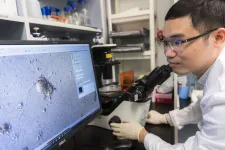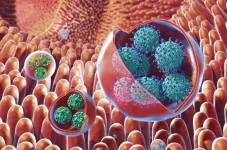(Press-News.org) Triple-negative breast cancer (TNBC) is an aggressive type of breast cancer with a high fatality rate. Currently, chemotherapy is the major treatment option, but the clinical result is unsatisfactory. A research team led by biologists at City University of Hong Kong (CityU) has identified and characterised a set of specific super-enhancers that stimulate the activity of the related critical cancer genes. The research has also discovered that the deletion of certain specific super-enhancers can reduce tumour cell growth. The latest findings may help discover new effective drug targets for TNBC patients to improve their survival chance.
Traditionally, cancer research has been focused on identifying gene mutations in different types of breast cancer. In contrast, how the epigenetic circuit affects cancers remains poorly characterised.
Epigenetic change: another way to induce cancers
While genetic mutation is a change in one or more parts of the DNA sequence, an epigenetic change also changes a gene's DNA, but not at the sequence level. Instead, special marks, called epigenetic marks, are added to or removed from the DNA sequence to change how a protein works in the body. And specific epigenetic marks are contained in super-enhancers. Deregulation, meaning abnormal regulation, of super-enhancers can therefore induce high production of cancer driver proteins and promote cancer formation.
To find out how these super-enhancers can affect TNBC cells, Dr Rebecca Chin Yuet-ming, a cancer biologist, and Dr Wang Xin, a computational biologist, both from the Department of Biomedical Sciences at CityU, joined hands together to lead the study. Their findings were published in the scientific journal Nature Communications, titled "Defining super-enhancer landscape in triple-negative breast cancer by multiomic profiling".
Integrating multi-level epigenomic sequencing data for 21 cell lines with gene expression data and clinical information for over 4,000 patient samples, Dr Wang's team used the method of multiomic profiling to perform in-depth data mining and built a specific super-enhancer-target regulatory network for all types of breast cancer.
A key regulator of cancer growth
"Our integrated analyses reveal that the clustering of super-enhancers is sufficient to characterise different subtypes of breast cancer," said Dr Wang. "Importantly, based on the regulatory network, we identify the gene FOXC1 as a key regulator of cancer growth and metastasis which is driven by a TNBC-specific super-enhancer. The FOXC1 is predictive of patients' survival and help develop therapeutic strategies targeting epigenetic circuits."
A number of key cancer driver genes (oncogenes), including FOXC1 and MET, are known to promote cancer growth and are associated with worse survival in TNBC patients. However, very little is known about how these genes being specifically highly expressed in TNBC. "Our network biology analysis uncovers FOXC1 as the master regulator of a large set of genes in metastasis. Using CRISPR/Cas9 technology, we further directly demonstrate that super-enhancer drives FOXC1 expression, and importantly, enhances cancer growth in mouse models," said Dr Chin.
By performing analysis on in-house clinical samples, the teams also learnt that FOXC1 upregulation is associated with higher tumour grade, cell division rate, and tumour-infiltrating immune cells.
Another TNBC-specific gene
The researchers went a step further and applied the integrated method to discover another new TNBC-specific gene ANLN. ANLN has been shown to be correlated with TNBC recurrence and poor survival rate in previous studies. In this study, the team found that the deletion of super-enhancer of ANLN could reduce the protein expression and tumour cell growth. "These findings demonstrate the power of leveraging epigenetic landscape to identify novel players in TNBC, paving the way to discover more effective therapeutic targets for this aggressive form of breast cancer," Dr Chin said.
Breast cancer is the most common type of cancer in women, with about 4,600 new cases of breast cancer being diagnosed in Hong Kong each year. Among all breast cancers, TNBC accounts for about 10-15%. Different from other types of breast cancer, TNBC does not express hormone receptors (namely estrogen receptors and progesterone receptors) and a protein called Her2, and that's where its name "triple-negative breast cancer" comes from. So TNBC is quite "invisible", and it is also difficult to heal as the scientists have not found an effective "target" on the TNBC cancer cell for the drugs to attack.
TNBC usually develops between the ages of 40-50, younger than the average breast cancer patients. Also, the time for TNBC metastasis is shorter. Patients typically relapse within 5 years of treatment, and is considered to have a poorer prognosis than other breast cancer forms.
"We hope our findings can contribute to the development of effective drugs for TNBC patients to improve their chance of survival," said Dr Chin.
INFORMATION:
Huang Hao and Hu Jianyang from CityU's BMS are the co-first authors of the study, and Dr Chin and Dr Wang are the corresponding authors. This study exemplified the fruitful multidisciplinary collaborations among research groups at CityU and health institutes. Dr Chan Kui-ming and Dr Zhang Liang from BMS co-authored the study. Scientists from Queen Elizabeth Hospital of Hong Kong and The Affiliated Tumor Hospital of Guangxi Medical University also contributed.
https://www.cityu.edu.hk/research/stories/2021/04/15/cityu-biologists-discover-super-enhancers-switch-breast-cancer-genes
A key portion of MIT's campus overlaps with Kendall Square, the bustling area in East Cambridge where students, residents, and tech employees scurry around in between classes, meetings, and meals. Where are they all going? Is there a way to make sense of this daily flurry of foot traffic?
In fact, there is: MIT Associate Professor Andres Sevtsuk has made Kendall Square the basis of a newly published model of pedestrian movement that could help planners and developers better grasp the flow of foot traffic in all cities.
Sevtsuk's work emphasizes the functionality of a neighborhood's elements, above and beyond its physical form, making the model one that could be ...
A new scientific discovery in Australia by Flinders University has recorded for the first time how ghost currents and sediments can 'undo' the force of gravity.
The new theory, just published in the Journal of Marine Systems, helps explain obscure events in which suspended sediment particles mysteriously move upward, not downward, on the slope of submarine canyons of the deep sea.
While this activity seems to contradict the laws of gravity, Flinders University physical oceanographer Associate Professor Jochen Kaempf has found an answer, devising the first scientific explanation of the observed upslope sediment transport.
"To put it simply, the vehicle of this transport are currents that, while carrying ...
Many long for a return to a post-pandemic "normal," which, for some, may entail concerts, travel, and large gatherings. But how to keep safe amid these potential public health risks?
One possibility, according to a new study, is dogs. A proof-of-concept investigation published today in the journal PLOS ONE suggests that specially trained detection dogs can sniff out COVID-19-positive samples with 96% accuracy.
"This is not a simple thing we're asking the dogs to do," says Cynthia Otto, senior author on the work and director of the University of Pennsylvania School of Veterinary Medicine Working Dog Center. "Dogs have to ...
Do freshwater snails make good tennis players? One of them certainly has the name for it.
Enter Travunijana djokovici, a new species of aquatic snail named after famous Serbian tennis player Novak Djokovic.
Slovak biospeleologist Jozef Grego and Montenegrin zoologist Vladimir Pesic of the University of Montenegro discovered the new snail in a karstic spring near Podgorica, the capital of Montenegro, during a field trip in April 2019. Their scientific article, published in the open-access, peer-reviewed journal Subterranean Biology, says they named it after Djokovic "to acknowledge his inspiring enthusiasm and energy."
"To discover some of the world's rarest animals that inhabit the unique underground habitats of the Dinaric karst, to reach inaccessible cave and spring habitats ...
WASHINGTON (April 15, 2021) -- Clusters of a virus known to cause stomach flu are resistant to detergent and ultraviolet disinfection, according to new research co-led by END ...
Since the 1970s, the Standard Model of Physics has served as the basis from which particle physics are investigated. Both experimentalists and theoretical physicists have tested the Standard Model's accuracy, and it has remained the law of the land when it comes to understanding how the subatomic world behaves.
This week, cracks formed in that foundational set of assumptions. Researchers of the "Muon g-2" collaboration from the Fermi National Accelerator Laboratory (FNAL) in the United States published further experimental findings that show that muons--heavy subatomic relatives of electrons--may have a larger "magnetic moment" than earlier Standard Model estimates had predicted, indicating that an unknown particle or force might be influencing ...
The DNA molecule is not naked in the nucleus. Instead, it is folded in a very organized way by the help of different proteins to establish a unique spatial organization of the genetic information. This 3D spatial genome organization is fundamental for the regulation of our genes and has to be established de novo by each individual during early embryogenesis. Researchers at the MPI of Immunobiology and Epigenetics in Freiburg in collaboration with colleagues from the Friedrich Mischer Institute in Basel now reveal a yet unknown and critical role of the protein HP1a in the 3D genome re-organization after fertilisation. The study published in the scientific journal Nature identifies HP1a as an epigenetic regulator that is involved in establishing ...
Leesburg, VA, April 15, 2021--A Scientific E-Poster to be presented at the 2021 ARRS Virtual Annual Meeting found that as the United States Medical Licensing Examination (USMLE) Step 1 transitions from a numerical score to pass or fail--as early as January 2022--radiology residency program directors will likely rely on USMLE Step 2 Clinical Knowledge (CK) scores as an objective and standardized metric to screen applicants.
"However," wrote lead investigator Rebecca Zhang of the University of Maryland School of Medicine in Baltimore, "program directors remain unsure whether they will ...
Leesburg, VA, April 15, 2021--A Scientific E-Poster to be presented at the 2021 ARRS Virtual Annual Meeting found that in the setting of a high pretest probability of COVID-19 infection or with a quick turnaround of the rapid real-time reverse transcriptase-polymerase chain reaction (RT-PCR) COVID-19 test, a chest x-ray (CXR) scoring system may be used prospectively to predict patient outcomes.
"We developed an accurate and reliable tool for classifying COVID-19 severity, which can be used both at the attending chest radiologist and junior resident level. This study identifies the laboratory, clinical and radiographic data that predict important patient outcomes such as death, intubation, and the need for chronic renal replacement ...
Scientists of Tomsk Polytechnic University has conducted research on the 35ClO2 isotope and developed a mathematical model and software, which allow predicting characteristics by 10 folds more accurate than already known results. The research work was conducted by a research team of Russian, German and Swiss scientists. The research findings are published in the Physical Chemistry Chemical Physics (IF: 3,4; Q1) academic journal and listed as one of the best articles.
The ClO2 molecule is extremely important for medicine and biophysics, as well as for the Earth atmosphere. It is used in medicine for disinfection and ...








